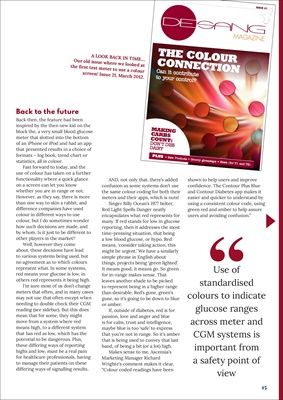
15
KIT
Back to the future
Back then, the feature had been
inspired by the then new kid on the
block the, a very small blood glucose
meter that slotted into the bottom
of an iPhone or iPod and had an app
that presented results in a choice of
formats - log book, trend chart or
statistics, all in colour.
Fast forward to today, and the
use of colour has taken on a further
functionality where a quick glance on
a screen can let you know whether
you are in range or not. However,
as they say, there is more than one
way to skin a rabbit, and difference
companies have used colour in
different ways to use colour, but
I do sometimes wonder how such
decisions are made, and by whom. Is
it just to be different to other players
in the market?
Well, however they come
about, these decisions have lead
to various systems being used, but
no agreement as to which colours
represent what. In some systems, red
means your glucose is low, in others
red represents it being high.
I'm sure most of us don't change
meters that often, and in many cases
won't even use one, if using a CGM
(see sidebar). But this does mean
that for some, they might move from
a system where red means high, to
a different system that has red as
low, which has the potential to be
dangerous. Plus, these differing ways
of reporting highs and low, must be a
real pain for healthcare professionals,
having to manage their patients on
these differing ways of signalling
results.
AND, not only that, there's added
A LOOK BACK IN TIME....
Our old issue where we looked at
the first test meter to use a colour
screen! Issue 21, March 2012.
confusion as some systems don't use
the same colour coding for both their
meters and their apps, which is nuts!
Singer Billy Ocean's 1977 belter,
Red Light Spells Danger neatly
encapsulates what red represents for
many. If red stands for low in glucose
reporting, then it addresses the most
time-pressing situation, that being
a low blood glucose, or hypo. Red
means, 'consider taking action, this
might be urgent.' We have a similarly
simple phrase in English about
things, projects being 'green lighted'.
It means good, it means go. So green
for in-range makes sense. That
leaves another shade to be picked
to represent being in a higher range
than desirable. Red's gone, green's
gone, so it's going to be down to blue
or yellow.
If, outside of diabetes, red is for
passion, love and anger and blue
is for calm, trust and intelligence,
maybe blue is too 'safe' to express
that you're not in range. So it's yellow
that is being used to convey that last
band, of being a bit (or a lot) high.
Makes sense to me.
www.dexcom.com/en-GB
Use of harmonised
(standardised)
colours for
indication of
glucose ranges
across BGM and
CGM systems is
important, from
a safety point of
view